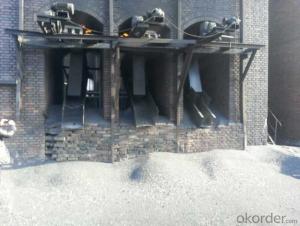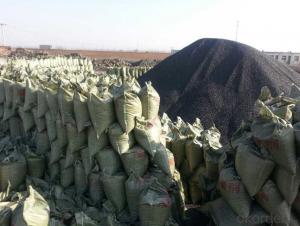Calcined Anthracite FC82-90 Made From Taixi Anthracite
- Loading Port:
- Lianyungang
- Payment Terms:
- TT OR LC
- Min Order Qty:
- 20 m.t.
- Supply Capability:
- 3500 m.t./month
OKorder Service Pledge
OKorder Financial Service
You Might Also Like
Calcined Anthracite FC82-90
Packaging & Delivery
25kgs/50kgs/1ton per bag or as buyer's request
Features
Calcined Anthracite
Fixed carbon: 90%-95%
S: 0.5% max
Size: 0-3. 3-5.3-15 or as request
It used the high quality anthracite as raw materials through high temperature calcined at over 2000 by the DC electric calciner with results in eliminating the moisture and volatile matter from anthracite efficiently, improving the density and the electric conductivity and strengthening the mechanical strength and anti-oxidation. It has good characteristics with low ash, low resistvity, low sulphur, high carbon and high density. It is the best material for high quality carbon products.
Advantage and competitive of caclined anthracite
1. strong supply capability
2. fast transportation
3. lower and reasonable price for your reference
4.low sulphur, low ash
5.fixed carbon:95% -90%
6..sulphur:lower than 0.3%
General Specification of Calcined Anthracite
| FC | 95 | 94 | 93 | 92 | 90 |
| ASH | 4 | 5 | 6 | 6.5 | 8.5 |
| V.M. | 1 | 1 | 1 | 1.5 | 1.5 |
| S | 0.3 | 0.3 | 0.3 | 0.35 | 0.35 |
| MOISTURE | 0.5 | 0.5 | 0.5 | 0.5 | 0.5 |
Pictures

- Q: What is carbon neutral?
- Carbon neutral refers to achieving a state where the net carbon emissions released into the atmosphere are balanced out by an equivalent amount of carbon removal or offsetting. This is typically achieved by reducing greenhouse gas emissions and investing in projects that remove carbon dioxide from the atmosphere, resulting in no net increase of carbon dioxide levels.
- Q: What are carbon credits?
- The aim of carbon credits is to lessen greenhouse gas emissions and combat climate change by using a market-based mechanism. These credits measure and quantify the reduction, removal, or avoidance of one metric ton of carbon dioxide (or its equivalent) from being released into the atmosphere. The concept behind carbon credits is rooted in the belief that certain activities or projects can offset the emissions caused by other activities. For example, renewable energy projects like wind farms or solar power plants can generate carbon credits by replacing the need for fossil fuel-based electricity generation. Similarly, projects focused on reforestation or afforestation can absorb carbon dioxide from the atmosphere and generate credits. These carbon credits can be purchased and sold in the carbon market, enabling companies or individuals to compensate for their own emissions by buying credits from projects that have successfully reduced or removed carbon dioxide from the atmosphere. This supports environmentally friendly initiatives and contributes to the overall reduction of greenhouse gases. The carbon credit system functions by creating financial incentives for activities that reduce emissions. It encourages businesses to invest in cleaner technologies and practices by assigning a monetary value to the reduction of carbon emissions. This drives the transition to a low-carbon economy and promotes sustainable development. Carbon credits play a crucial role in international efforts to tackle climate change. They are often used as a compliance mechanism for countries or companies to meet their emission reduction targets, as outlined in international agreements like the Kyoto Protocol or the Paris Agreement. Additionally, they contribute to the overall objective of limiting global temperature rise by encouraging emission reductions beyond regulatory requirements. While carbon credits have faced criticism for potentially allowing companies to continue polluting by simply purchasing credits, they remain an important tool in the fight against climate change. They provide economic benefits to sustainable projects and encourage the adoption of cleaner technologies, ultimately helping to mitigate the environmental impact of human activities.
- Q: Why is the solubility of carbon in austenite larger than that in ferrite?
- Ferrite: interstitial solution of carbon formed in alpha Fe.Austenite: interstitial solid solution formed by carbon in gamma Fe.The ferrite structure is a BCC lattice with a gap radius (0.291~0.154). Because of the smaller size of the lattice gap, the solubility of carbon in alpha -Fe is relatively small.
- Q: How does carbon impact the prevalence of wildfires?
- There are several ways in which carbon affects the occurrence of wildfires. First and foremost, carbon dioxide (CO2) is a greenhouse gas that contributes to climate change. As the concentration of CO2 increases in the atmosphere, temperatures rise, resulting in drier conditions in many areas. These dry conditions create a more favorable environment for the ignition and spread of wildfires. Moreover, carbon plays a significant role in the amount of fuel available to feed wildfires. Carbon-based materials, such as dead vegetation, trees, and other organic matter, serve as the main source of fuel for fires. As carbon accumulates in ecosystems, either naturally or through activities like deforestation, the potential fuel for wildfires increases. This increased fuel load can lead to more frequent and intense fires. In addition, carbon has an impact on the health and vitality of forests. Higher levels of atmospheric CO2 can enhance plant growth, resulting in denser vegetation. Although this may seem beneficial, it actually contributes to the intensity and severity of wildfires. Denser vegetation means there is a greater amount of fuel available, especially when combined with the dry conditions caused by climate change. This combination becomes a recipe for more destructive fires. Lastly, the combustion of carbon-based materials during wildfires releases large amounts of carbon dioxide into the atmosphere. This creates a positive feedback loop, as the increased carbon emissions contribute to further climate change, which, in turn, worsens the conditions for wildfires. In summary, carbon plays a critical role in determining the occurrence and severity of wildfires through its impact on climate change, fuel load, forest health, and the release of greenhouse gases during combustion. It is essential to address carbon emissions and implement effective forest management practices in order to mitigate the risks and consequences associated with wildfires.
- Q: How is carbon used in the production of ink?
- Various forms of carbon, such as carbon black or activated carbon, are employed in the production of ink. Carbon black, a fine black powder derived from incomplete petroleum combustion, is commonly used as a pigment to achieve deep black color in inks. Its small size and high surface area enable even dispersion in the ink, ensuring consistent color. On the other hand, activated carbon is a porous carbon form produced by heating materials like wood or coconut shells at high temperatures. In ink production, it functions as a filter or purification agent. With its extensive surface area and microscopic pores, activated carbon effectively adsorbs contaminants and impurities from the ink, enhancing its quality and stability for a smooth flow. In addition to its purification role, carbon also serves as a conductive material in ink production. Carbon-based inks, widely utilized in applications requiring electrical conductivity such as printed circuit boards, sensors, or electronic devices, consist of dispersed carbon particles in a liquid medium. This allows them to be printed or deposited onto a substrate, creating conductive pathways. Overall, carbon's vital role in ink production encompasses providing color, acting as a purification agent, and enabling electrical conductivity. Its adaptable properties and vast range of applications establish it as an indispensable component in the ink manufacturing process.
- Q: What is carbon fiber reinforced polymer?
- Carbon fiber reinforced polymer (CFRP) is a composite material that combines carbon fibers with a polymer matrix, resulting in a strong and lightweight material. Carbon fibers are thin, strong, and composed of carbon atoms bonded together in a crystalline structure. These fibers are embedded in a polymer matrix, typically made of epoxy resin, which binds the fibers together and provides support. The combination of carbon fibers and polymer matrix results in a material that has a high strength-to-weight ratio, making it ideal for various applications. CFRP is known for its exceptional stiffness, strength, and resistance to corrosion and fatigue. It is extensively used in aerospace, automotive, sports equipment, and other industries where lightweight and high-performance materials are required. The unique properties of CFRP make it an excellent alternative to traditional materials like steel, aluminum, and fiberglass, providing superior strength and durability while significantly reducing weight.
- Q: How do you remove the carbon stains on your clothes?
- 1, first pour alcohol on clothes, fountain pen scratches, every scratch should be evenly covered with alcohol, alcohol should be used at a concentration of not less than 75% of the medical alcohol.2, pour the clothes down, put this side of the alcohol up, try not to touch other surfaces of the clothes, otherwise, the color of the pen or ballpoint pen may be stained with other parts of the clothes.3, with ordinary washbasin, ready most of the basin of water, and then will be full of two bottles of bleach water poured in the water, pay attention to must be full two bottle cap.4, take a stir, and then add a little washing powder, this amount can be mastered.5, after a little mixing, so that washing powder can be fully dissolved in water. Well, now soak your clothes in water for twenty minutes.
- Q: What is the atomic weight of carbon?
- The atomic weight of carbon is approximately 12 atomic mass units.
- Q: Can carbon 14 identify the age of porcelain?
- Identification of porcelain by carbon 14 is not very accurate.The so-called carbon fourteen assay, radiocarbon dating, uses the carbon fourteen, which is widely found in nature, to measure the age of animals and plants. In prehistoric and ancient, the smaller the impact of human activities on the earth's environment, and carbon in nature fourteen proportions remain constant, animals and plants in the survival time, due to its in vivo The new supersedes the old. sake, carbon fourteen also remained constant; however, the once dead, in fourteen carbon will continue to decay, the half-life is 5730 years, in the sealed state and the outside world is obviously different, which is the principle of carbon fourteen dating. We must note that animals and plants belong to the organic matter. However, most cultural relics, such as porcelain, pottery and bronze, are inorganic. Therefore, the application of carbon fourteen dating in archaeology is very limited.
- Q: The same manufacturer of different types of badminton rackets on the logo, but the two materials in the end what is the difference?
- Under the same force, high elasticity means that the elongation of the fiber is relatively large, and the high rigidity means that the elongation is relatively small.The racket hit the ball using high elastic fiber can withstand greater deformation, good toughness, a slowerThe racket hit the ball using high rigid fibers during deformation is small, hit the ball faster.
Send your message to us
Calcined Anthracite FC82-90 Made From Taixi Anthracite
- Loading Port:
- Lianyungang
- Payment Terms:
- TT OR LC
- Min Order Qty:
- 20 m.t.
- Supply Capability:
- 3500 m.t./month
OKorder Service Pledge
OKorder Financial Service
Similar products
Hot products
Hot Searches


























